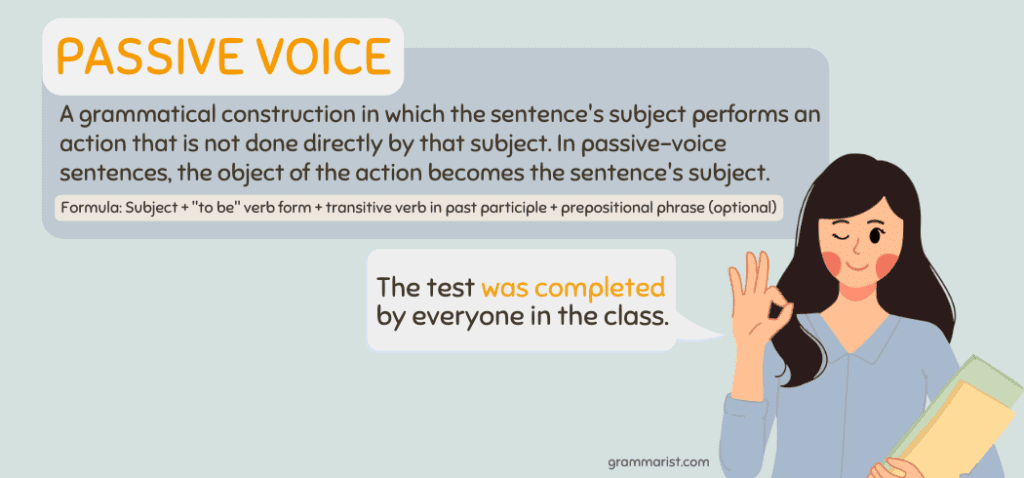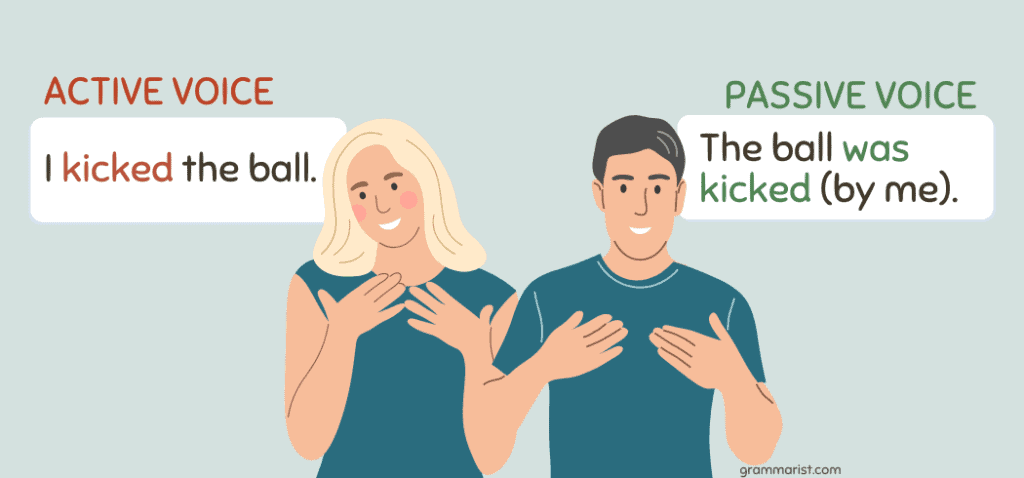To be a successful writer in any sense, it’s important to understand how to correctly use the different parts of speech. I’ve learned this first-hand as a writer and published author for over a decade. One of these parts is the passive voice, which can often be misused. I see it all the time. My guide will discuss passive voice and how to use it correctly. I’ve also included a worksheet for you to practice using the passive voice. Let’s get started!
The Use of Passive Voice
There is much debate surrounding the use of passive voice in writing. Some believe that using passive voice is inherently bad and can even negatively impact readers’ comprehension. Others, however, argue that there are certain instances where passive voice can effectively make writing more engaging or interesting.
What Is Passive Voice and When to Use It?

Passive voice is a grammatical construction in which the sentence’s subject performs an action that is not done directly by that subject. In passive-voice sentences, the object of the action becomes the sentence’s subject.
This can be used as a stylistic choice in writing to emphasize specific elements of a story or argument or to make a description more concise and avoid sounding repetitive.
However, it can sometimes mask the true actor initiating that action, so it should be used carefully and only when appropriate. When deciding whether to use passive voice in your writing, consider the function of each sentence and what you’re attempting to achieve with your style and content.
How Do You Identify a Passive Voice?
Passive voice is a grammatical construction in which the subject receives an action. In standard English, this is often indicated by using a form of “to be” plus a past participle. For example, in the sentence “The ball was hit by Mary,” the passive voice uses “was hit” instead of “hit.”
Because passive voice sentences often emphasize certain elements over others and may need to be clearer than active voice sentences, it can sometimes be difficult to identify them.
One reliable way to identify passive voice is to look for forms of “to be” that are not in their simple conjugation or infinitive forms (am, is, etc.).
Seeing the word “by” paired with a noun or pronoun could indicate passive voice construction. Finally, if the sentence feels unnatural or awkward and does not clearly name an agent performing the action (also known as a subject), it could be constructed using passive voice.
Recognizing when something is written in passive voice takes some practice, but paying attention to word choice, tense agreement, and structure can help you make accurate grammatical judgments. I’m guilty of slipping into the passive voice from time to time, but I know how to spot it now and fix it to flow better.
Why Is Passive Voice Used?
Passive voice is often used in writing for a variety of reasons.
Firstly, it can be used to place greater emphasis on the reader or listener. By shifting the focus from the subject to the object, passive voice can help to highlight important information and draw attention to specific details.
Passive voice effectively creates a detached tone, which can help convey an unbiased point of view in academic or formal writing.
Finally, passive voice can enable the writer or speaker to evade responsibility by obscuring the agent’s identity when making action happen.
Here are some specific situations that call for passive voice use:
- When reporting incidents and crimes with unknown authors
- When the emphasis falls on the action and the subject is not important
- In scientific papers and research
Here are correct passive voice usage examples:
- Two cars were stolen last night.
- Lady Gaga was awarded as the best singer in 2011.
- The cure for cancer was discovered.
What Are the Rules for Passive Voice?
When writing or speaking in passive voice, the clause’s subject is the one receiving the verb’s action. The correct passive voice formula is subject + “to be” verb form + transitive verb in past participle + prepositional phrase (optional).
Passive voice examples:
- The test was completed by everyone in the class.
- This essay wasn’t written by any of our students.
Now Let’s See Them in Active Sentences
- Everyone in the class completed the test.
- None of our students wrote the essay.
See how the active sentence structure is more concise and direct.
The Difference Between Active and Passive Voice

There is a common misconception that the difference between active and passive voices is simply whether a sentence contains an action or not. However, this is only sometimes the case. Rather, active and passive voice refers to relationships between subjects and objects in a sentence.
With active voice, the subject acts on the object directly; passive voice is the other way around. In general, the active voice tends to be clearer and more concise than the passive voice, making it a better choice for most types of writing.
This is because, in sentences using passive voice, there is often an abundance of unnecessary words and phrases that take away from the original meaning of the sentence.
For example:
- Active voice: I kicked the ball.
- Passive voice: The ball was kicked (by me).
Creative Ways to Use the Passive Voice in Writing
There are many clever ways of using the passive voice in writing, and each method can bring unique benefits to your work. For example, one technique is to use passives as nominalizations or nouns created from verbs. Doing so can create concise, action-oriented phrases that pack a lot of punch.
In addition, you could also try drawing comparisons between two unrelated objects or ideas through passive construction. This approach can help to make complex ideas more accessible and understandable for your readers.
Passive Voice Misuse
Passive voice is often misused in writing, either due to a poor understanding of what this technique entails or simply because it sounds better. However, to get the most out of passive voice, you must use it appropriately and with caution.
In general, passive voice is best used to emphasize the receiver or result of an action instead of the agent performing that action. It can also help to make simple instructions sound more sophisticated, yet using passive voice can be tricky when it comes to complex actions or stating opinions.
When used correctly and sparingly, however, passive voice can add a level of nuance and complexity to your writing that will keep your readers engaged and interested.
When Should I Avoid Passive Voice?
It all comes down to one question: is passive voice bad?
If you ask my editor, she’ll say yes, but I don’t always agree. There are many situations where it is preferable to use active voice instead of passive voice. Generally, active voice is more efficient and immediate, as it involves focusing on the actor and making it clear who or what is responsible for creating a particular situation.
Additionally, the active voice tends to be more engaging and exciting, drawing the reader in with its immediacy.
Therefore, when writing about a process or action that you want to appear direct and efficient, it is best to refrain from using passive voice whenever possible.
Weeding Out Passive Sentences
When it comes to writing, the use of passive voice sentences can often leave your work feeling flat and uninteresting. Passive voice is characterized by a lack of agency, with the subject of the sentence appearing as though it is being acted upon rather than acting or taking an active role in the action.
While there are certain situations where passive voice may be appropriate, it should be avoided. Weeding out passive verbs and replacing them with more direct and engaging verbs can help you to give your sentences a more active and dynamic feel.
Whether you are writing an academic paper or a social media post, paying attention to your use of passive voice can help you craft more powerful and interesting content.
Final Words
While people consider passive voice incorrect, it’s a matter of style and knowing when to use it. Active voice makes everything sound more natural, whereas passive voice requires specific uses. Forming the passive voice is simple as long as you remember to use the verb “to be” and a past participle. Make sense?